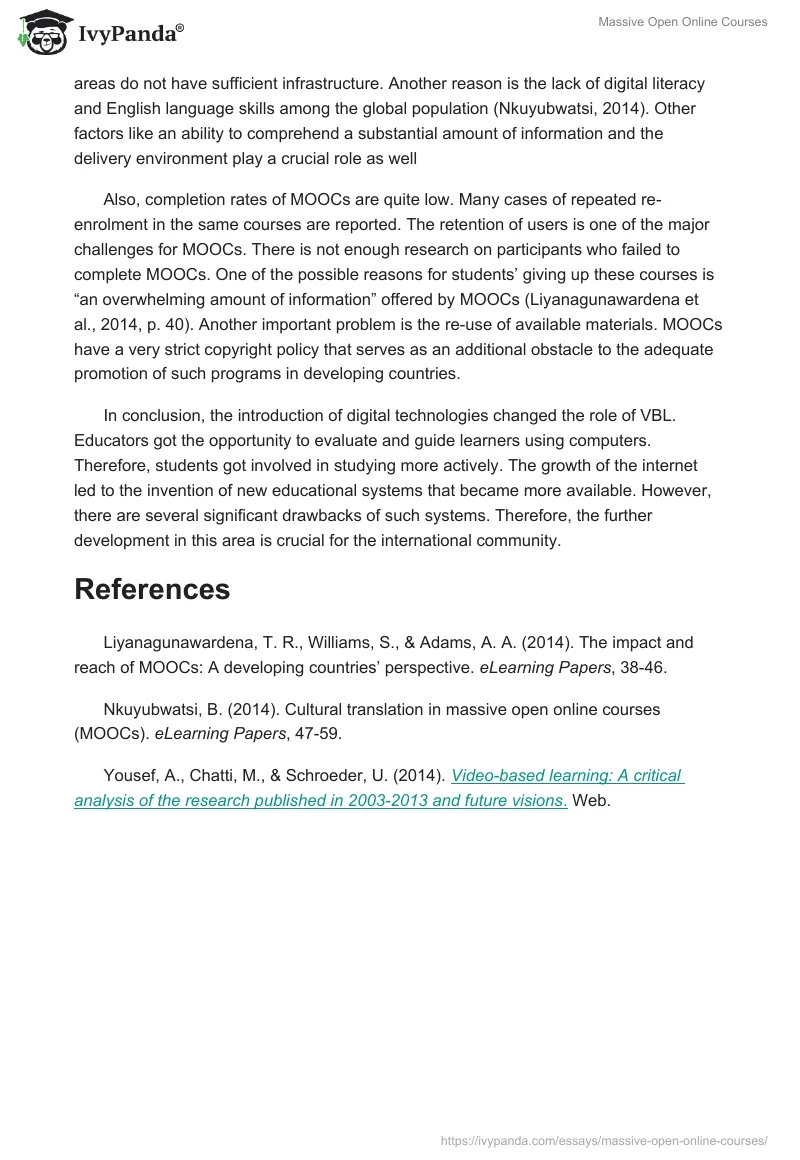Video-based learning (VBL) has a long history of development. First attempts were made at the time of the World War II. VBL were used to train soldiers. This method was very effective and led to the significant improvement of their skills. Subsequently, VBL becomes a more popular instrument in an educational process. Such videos also improved the professional competence of educators. By the late 1980’s, the development of video technologies made it easier to incorporate VBL in an educational system (Yousef, Chatti, & Schroeder, 2014). One of the most recent advances is massive open online courses (MOOCs). These courses provide access to educational material for a wider audience. MOOCs offer not only video lessons and practice materials but also interactive forums where users can get support from teachers and other students. Although distance education benefits numerous people, it has certain drawbacks as well. The main goal of this paper is to discuss MOOCs, highlighting their advantages and disadvantages.
Publications on that matter have become more relevant in recent years. Various specialists discuss ways for the improvement of VBL. The most relevant question is how to increase the effectiveness of VBL methods taking into account academic achievements of students and professional skills of educators. The introduction of MOOCs has changed the course of the development of VBL. This innovation offers many options to users. MOOCs are used by educational institutions across the globe. The international community needs more educational opportunities. For example, in India, “40 million additional university places are estimated to be required by 2025” (Liyanagunawardena, Williams, & Adams, 2014, p. 38). MOOCs can help to resolve this problem. Educational specialists divided MOOCs into several categories. The first category is connectivist MOOCs. They were designed in order to enhance collaboration and information exchange. The second category is xMOOCs. This model was developed to meet growing demands of institutions. The third category is artificial intelligence Stanford like courses that are focused on the aggregation, altering, and development of resources.
However, MOOCs are mostly used in North America and Europe. According to Liyanagunawardena et al. (2014), “there is very limited participation from Asia and even less from Africa” (p. 39). There are various reasons for that. First, most towns and rural areas do not have sufficient infrastructure. Another reason is the lack of digital literacy and English language skills among the global population (Nkuyubwatsi, 2014). Other factors like an ability to comprehend a substantial amount of information and the delivery environment play a crucial role as well
Also, completion rates of MOOCs are quite low. Many cases of repeated re-enrolment in the same courses are reported. The retention of users is one of the major challenges for MOOCs. There is not enough research on participants who failed to complete MOOCs. One of the possible reasons for students’ giving up these courses is “an overwhelming amount of information” offered by MOOCs (Liyanagunawardena et al., 2014, p. 40). Another important problem is the re-use of available materials. MOOCs have a very strict copyright policy that serves as an additional obstacle to the adequate promotion of such programs in developing countries.
In conclusion, the introduction of digital technologies changed the role of VBL. Educators got the opportunity to evaluate and guide learners using computers. Therefore, students got involved in studying more actively. The growth of the internet led to the invention of new educational systems that became more available. However, there are several significant drawbacks of such systems. Therefore, the further development in this area is crucial for the international community.
References
Liyanagunawardena, T. R., Williams, S., & Adams, A. A. (2014). The impact and reach of MOOCs: A developing countries’ perspective. eLearning Papers, 38-46.
Nkuyubwatsi, B. (2014). Cultural translation in massive open online courses (MOOCs). eLearning Papers, 47-59.
Yousef, A., Chatti, M., & Schroeder, U. (2014). Video-based learning: A critical analysis of the research published in 2003-2013 and future visions. Web.


